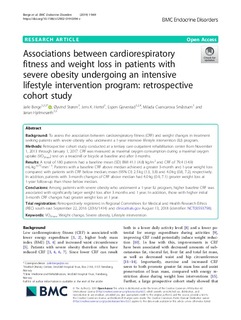| dc.contributor.author | Berge, Jarle | |
| dc.contributor.author | Støren, Øyvind | |
| dc.contributor.author | Hertel, Jens Kristoffer | |
| dc.contributor.author | Gjevestad, Espen Svendsen | |
| dc.contributor.author | Småstuen, Milada Cvancarova | |
| dc.contributor.author | Hjelmesæth, Jøran | |
| dc.date.accessioned | 2019-09-19T14:37:26Z | |
| dc.date.available | 2019-09-19T14:37:26Z | |
| dc.date.created | 2019-07-08T14:46:34Z | |
| dc.date.issued | 2019 | |
| dc.identifier.citation | BMC Endocrine Disorders. 2019, 19 (1), 1-9. | nb_NO |
| dc.identifier.issn | 1472-6823 | |
| dc.identifier.uri | http://hdl.handle.net/11250/2617929 | |
| dc.description | Open Access This article is distributed under the terms of the Creative Commons Attribution 4.0 International License which permits unrestricted use, distribution, and reproduction in any medium, provided you give appropriate credit to the original author(s) and the source, provide a link to the Creative Commons license, and indicate if changes were made. The Creative Commons Public Domain Dedication waiver | nb_NO |
| dc.description.abstract | Background
To assess the association between cardiorespiratory fitness (CRF) and weight changes in treatment seeking patients with severe obesity who underwent a 1-year intensive lifestyle intervention (ILI) program.
Methods
Retrospective cohort study conducted at a tertiary care outpatient rehabilitation center from November 1, 2013 through January 1, 2017. CRF was measured as maximal oxygen consumption during a maximal oxygen uptake (VO2max) test on a treadmill or bicycle at baseline and after 3 months.
Results
A total of 180 patients had a baseline mean (SD) BMI 41.1 (4.8) kg/m2 and CRF of 79.4 (14.9) mL·kg-0.75·min− 1. Patients with a baseline CRF above median achieved a greater 3-month and 1-year weight loss compared with patients with CRF below median; mean (95% CI) 2.5 kg (1.3, 3.8) and 4.0 kg (0.8, 7.2), respectively. In addition, patients with 3-month changes of CRF above median had 4.0 kg (0.9, 7.1) greater weight loss at 1-year follow-up than those below median.
Conclusions
Among patients with severe obesity who underwent a 1-year ILI program, higher baseline CRF was associated with significantly larger weight loss after 3 months and 1 year. In addition, those with higher initial 3-month CRF changes had greater weight loss at 1 year.
Trial registration
Retrospectively registered in Regional Committees for Medical and Health Research Ethics (REC) south east September 22, 2016 (2016/1414) and clinicaltials.gov August 13, 2018 (identifier: NCT03593798) | nb_NO |
| dc.language.iso | eng | nb_NO |
| dc.rights | Navngivelse 4.0 Internasjonal | * |
| dc.rights.uri | http://creativecommons.org/licenses/by/4.0/deed.no | * |
| dc.title | Associations between cardiorespiratory fitness and weight loss in patients with severe obesity undergoing an intensive lifestyle intervention program: retrospective cohort study | nb_NO |
| dc.type | Journal article | nb_NO |
| dc.type | Peer reviewed | nb_NO |
| dc.description.version | publishedVersion | nb_NO |
| dc.rights.holder | © The Author(s). 2019 | nb_NO |
| dc.source.pagenumber | 1-9 | nb_NO |
| dc.source.volume | 19 | nb_NO |
| dc.source.journal | BMC Endocrine Disorders | nb_NO |
| dc.source.issue | 1 | nb_NO |
| dc.identifier.doi | 10.1186/s12902-019-0394-z | |
| dc.identifier.cristin | 1710660 | |
| cristin.unitcode | 222,58,0,0 | |
| cristin.unitcode | 222,59,4,0 | |
| cristin.unitname | Fakultet for teknologi, naturvitenskap og maritime fag | |
| cristin.unitname | Institutt for friluftsliv, idrett og kroppsøving | |
| cristin.ispublished | true | |
| cristin.fulltext | original | |
| cristin.qualitycode | 1 | |

